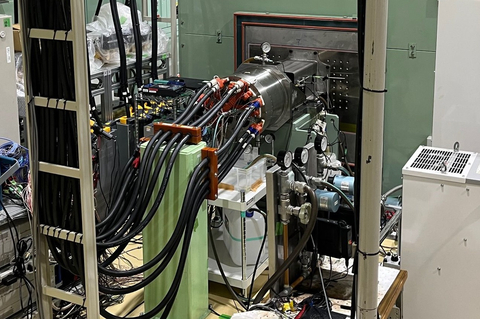
IHI Brings Planet Closer to a Carbon-Free Future by Developing World’s First Aircraft Engine-Embedded Megawatt-Class Electric Motor
Published by Todd Bush on January 13, 2024
TOKYO--(BUSINESS WIRE)--IHI Corporation (TOKYO: 7013) announces today it and several domestic partners jointly developed the world’s first one-megawatt-class (see note 1) electric motor (note 2) mounted inside a jet engine tail cone (note 3). This achievement is one fruit of the company’s More Electric Architecture for Aircraft and Propulsion (MEAAP) project. This technological innovation initiative aims to optimize the overall energy management of aircraft systems, including engines, to help cut their carbon dioxide emissions.

>> Additional Reading: Sirius Aviation AG Unveils World's First Hydrogen VTOL Aircraft: Sirius Jet
IHI developed this motor as part of R&D into advanced electric propulsion systems and electric hybrid systems under the Research and Development of Advanced Aircraft Systems for Practical Application Project of Japan’s New Energy and Industrial Technology Development Organization.
The global passenger jet fleet should double over the next 20 years on growing travel demand, although the United Nations’ International Civil Aviation Organization targets virtually zero carbon dioxide emissions from these aircraft by 2050. It is accordingly important to improve conventional technologies while innovating aircraft systems that maintain safety and economy and make them more eco-friendly.

The MEAAP project seeks not just to electrify aircraft but also to significantly enhance fuel efficiency by optimizing aircraft systems, including engines, to reuse cabin air, which current designs discharge outside aircraft without using effectively, to cool electrical equipment. This would eliminate the need for complex conventional hydraulic, pneumatic, and other systems, thus boosting design freedom and maintainability while reducing weight. IHI is collaborating with domestic and overseas partners in various R&D efforts to achieve its MEAAP goals.
IHI’s new engine-embedded electric motor could provide power for aircraft and also serve as a key technology in hybrid electric propulsion systems for which R&D is underway around the world.
In March 2020, IHI developed a 250-kilowatt-class engine-embedded electric motor offering the largest generator capacity for currently operating passenger aircraft. At the time, it developed a high-density molded coil technology with a 300°C heat-resistant insulation coating (note 4). It has additionally developed an exhaust heat system technology that taps thermal, fluid, and structural technologies that the company cultivated in jet engine R&D. It has augmented these advances to improve efficiency by overhauling the power generation mechanism to create an electric motor that can deliver more than one megawatt of power. The motor offers output scalability as required.
For its new motor, IHI conducted assessments at the Evaluation Laboratory for Next Generation Motors of the Akita University Joint Research Center for Electric Architecture** (note 5). This is the largest such facility in Japan. This work confirmed that the company could attain the anticipated revolutions per minute when connecting the engine shaft directly to the inside of the tail cone.
IHI will keep developing hybrid electric propulsion systems to electrify aircraft, and looks to demonstrate an engine-embedded electric motor during the middle of this decade. By combining a high-power electric motor for aircraft propulsion (note 6), an electric turbo compressor (note 7), a high-flux plastic magnet rotor (note 8), and an electric hydrogen turbo-blower (note 9), which are also under development, IHI will electrify and optimize a range of propulsion systems, including hybrid electric propulsion systems for the future, and aircraft systems overall.
Subscribe to the newsletter
Daily decarbonization data and news delivered to your inbox
Follow the money flow of climate, technology, and energy investments to uncover new opportunities and jobs.
Latest issues
-
SAF Output Doubled, So Why Is IATA Sounding Alarms?
Happy New Year from Decarbonfuse! As we wrap up 2025, we want to thank you for being part of the growing Decarbonfuse community. Your engagement and feedback have helped make this platform a trust...
-
$213 Per Tonne: Inside the Latest Multi-Pathway CDR Deal
Inside This Issue 💸 $213 Per Tonne: Inside the Latest Multi-Pathway CDR Deal 🏛️ Clean Energy Technologies Affiliate Vermont Renewable Gas Advances Regulatory Review 💧 Fusion Fuel’s BrightHy Soluti...
-
The Three-Continent Move That Redefines SAF
Wishing everyone a restful holiday season.🎄🎅🎁 Inside this Issue ✈️ Cathay Goes Global With SAF in Three-Continent Fuel Deal 🧪 Proton Ventures Partners With Barents Blue For Realization Of The Bar...
Company Announcements
-
HyOrc Completes Factory Acceptance Test of 500kW ORC Turbine for International Customer
HOUSTON, Dec. 31, 2025 (GLOBE NEWSWIRE) -- HyOrc Corporation (OTCID: HYOR), a clean-energy technology company, today announced the successful completion of the Factory Acceptance Test (FAT) for its...
-
Nova Sustainable Fuels Receives Approval to Produce Sustainable Aviation Fuel in Guysborough County
Nova Sustainable Fuels has received environmental assessment approval for the first phase of a project that will see the company develop a renewable energy park in Goldboro, Guysborough County, whe...
-
Darling Ingredients Announces Sale of Approximately $50 Million in Production Tax Credits
IRVING, Texas -- Darling Ingredients Inc. (NYSE: DAR) today announced the sale of approximately $50 million of production tax credits to a corporate buyer. These credits were generated under the In...
-
Aemetis Receives Funds From the Sale of $17 Million of Federal Clean Energy Tax Credits
CUPERTINO, Calif., Dec. 30, 2025 (GLOBE NEWSWIRE) -- Aemetis, Inc. (NASDAQ: AMTX), a renewable natural gas and renewable liquid fuels company focused on lower cost and reduced emissions products, t...